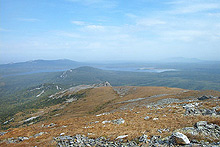National Park “Zyuratkul”
National park “Zyuratkul” was established as a national park on November 3, 1993. It is situated in the Satkinsky District and is 215.3 thousand acres in area. Zyuratkul is one of the few territories in the Chelyabinsk Region preserved in their natural state. It contains 15 relics natural relics, a large variety of flora (650 in all) and also more than 150 bird and 44 mammal species live here. Remnants of 11 stone-age human habitations have been found on the banks of the mountain lake Zyuratkul – the park’s major attraction to travelers.
 |
|
This lake is situated 724 metres above the Baltic Sea level and has a volume of 80 million cubic metres. It is fed by springs and about 20 rivers and small streams with only the Bolshaya Satka river having it’s source there. It is retained by a dam and covers an area of 13.2 square kilometers, has an average depth of 4-5 metres (maximum 12 metres) and a circumference of 26 kilometres. This unique lake is the only one in the southern Urals which lays on the western slopes.
Water exchange is high - the entire volume of water is replaced each year. Lake Zyuratkul, a hydrological natural icon, is the main freshwater reservoir in the Chelyabinsk Region. Rivers flowing through the park are few and don’t carry a lot of water, but, to make up for it, their water is pure and transparent – a perfect home for grayling, burbot (eel-pout), crucian, gudgeon, perch, ruff, small fry and others.
The animal world of the national park is abundant and diverse. About 40 animal species inhabit the park’s forested areas, mountain plateaus and low-lying marshy lands. Zyuratkul’s wildlife includes bears and elks (as the largest animals), fur-bearing animals such as hares and squirrels, as well as minks, martens, and red-furred foxes and there are almost 150 different kinds of birds winging the skies overhead.
Around Lake Zyuratkul there are a few mountain ranges - Nourgoush mountain range being the most dominant. It is the highest mountain ridge (1406 metres) in the Chelyabinsk Region. At the top of the rugged mountains there is a broad plateau covered with tundra vegetation. This plateau is one of the most remarkable sights of the park. It is a popular belief that Father Frost (Father Christmas) actually lives here. The Zyuratkul mountain range (1175 ì) is made distinctive by a group of three giant mountain ridges titled “Bears”. Geologists discovered the rare “paleovolcano” (“Moscal” ridge), containing a vast underground store of minerals (more than 70 types) in its crater - the stones being found in an area of only one square kilometre – truly a phenomenon on a world scale!
 During the last 60 years of the XXth century, 12 archeological monuments were discovered here. All of them relating to the Stone Age - an epoch of Mesolithic and Neolithic times (VII-V thousand years B.C.). These sites contain the remnants of life of hunters and fishers who lived here for a short duration. They settled down at the mouths of the small rivers (sites Small Kyl and Big Kyl) and on the capes, which jut out into the lake (parking Sandy Cape, Birch Cape). The great bulk of finds on these sites was pottery, work instruments made from stone, their fragments and waste products of manufacture. During the last 60 years of the XXth century, 12 archeological monuments were discovered here. All of them relating to the Stone Age - an epoch of Mesolithic and Neolithic times (VII-V thousand years B.C.). These sites contain the remnants of life of hunters and fishers who lived here for a short duration. They settled down at the mouths of the small rivers (sites Small Kyl and Big Kyl) and on the capes, which jut out into the lake (parking Sandy Cape, Birch Cape). The great bulk of finds on these sites was pottery, work instruments made from stone, their fragments and waste products of manufacture.
In the national park “Zyuratkul” there are so many fascinating places. Come to the park in the winter and you will see a strange sculpture made from blue ice – the ice fountain. A thin jet of ice water soars upwards almost to a height of 10 metres but in winter a column of pure(clean) blue ice 14 metres high freezes on the fountain. This fountain actually has an artificial origin - geologists once drilled a hole from which the jet of tasty, cold water (even in the hottest time) began spout upwards. Since then this unusual “fountain” in the taiga has been an attraction for many tourists.
 
|

